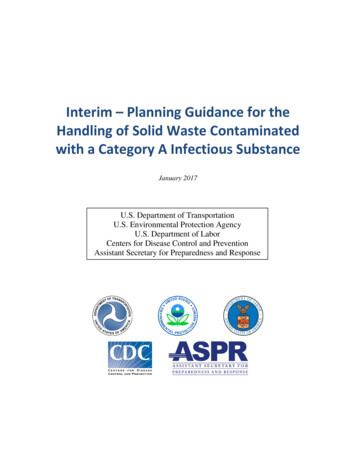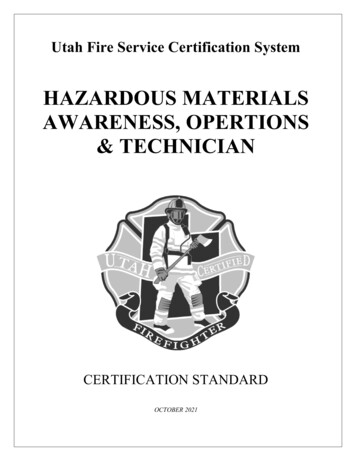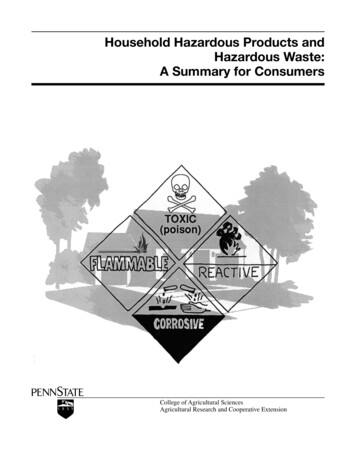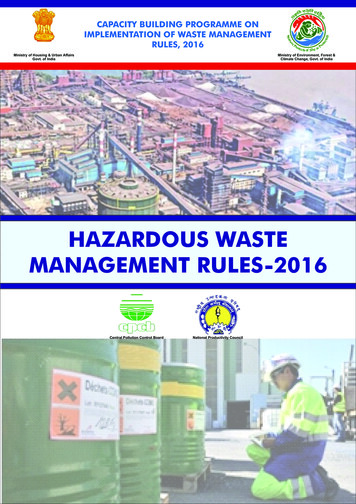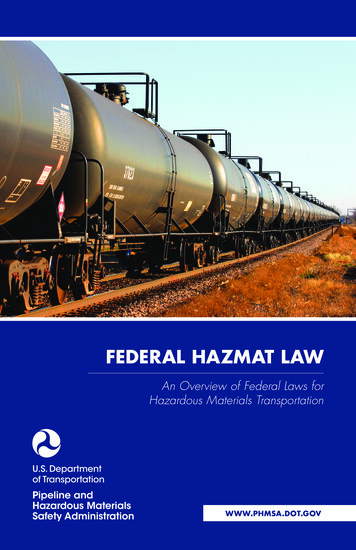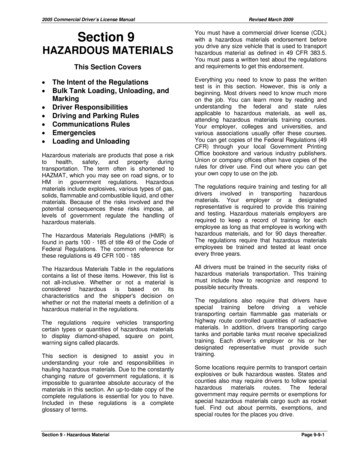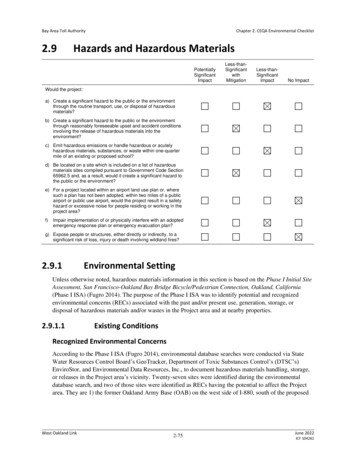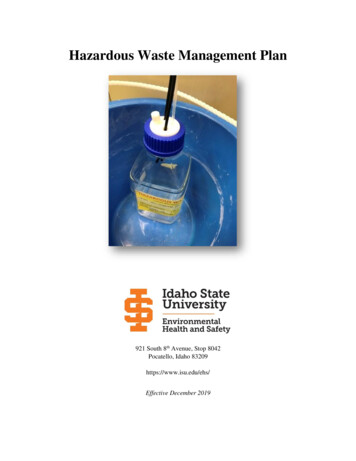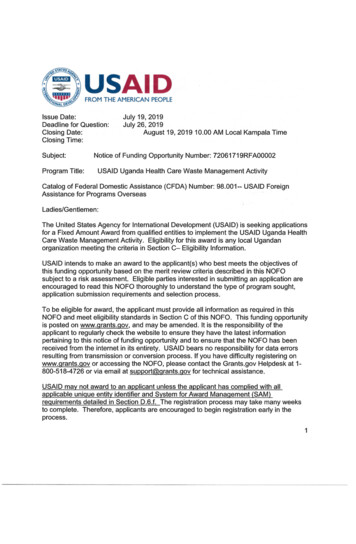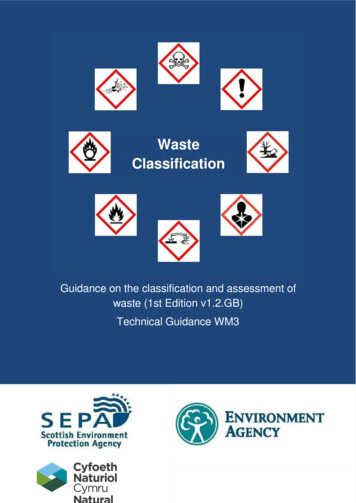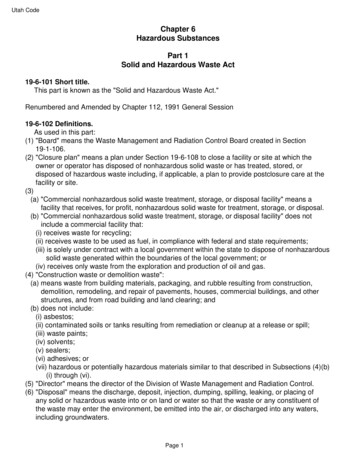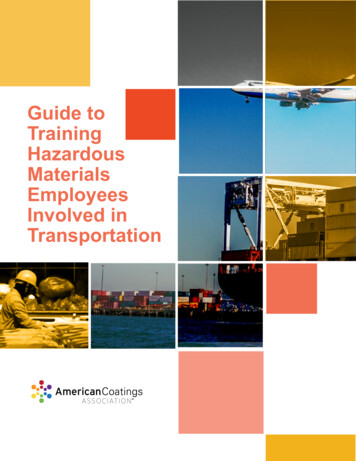
Transcription
Guide toTrainingHazardousMaterialsEmployeesInvolved inTransportation
Guide to Training Hazardous MaterialsEmployees Involved in TransportationFifth EditionPublished by the American Coatings Association901 New York Ave NW, Suite 300 West, Washington, DC 20001Phone: (202) 462-6272 Fax: (202) 462-8549 Email: members@paint.org 1993 by the American Coatings Association, Inc. All rights reserved Reprinted in 1994, 1997, 1998, 2005, 2019
TABLE OF CONTENTSPreface. 1Introduction. 2Training Requirements. 4Guide Overview. 8Chapter 1 – How to Use the HazardousMaterials Regulations. 91.1 The Hazardous Materials Regulations . 91.2 How to Read the Hazardous Materials Regulations .9Chapter 2 – How to Use the Hazardous Materials Table. 11Test Evaluation – How to Use of the Hazardous Materials Table.15Chapter 3 – Classification. 183.1 Objective.183.2 Introduction.183.3 Definition of a Hazardous Material.183.4 Hazard Classification Objective.193.5 Hazard Classification Process.203.6 Is this Material Regulated for Transportation?.213.7 Determining the Hazard Class.213.8 Choosing a Proper Shipping Name.283.9 Exceptions.29Test Evaluation – Hazard Classification.32Chapter 4 – Packaging. 354.1 Introduction.354.2 Overview of Performance-Oriented Packaging.354.3 Shipper Responsibilities, §173.22.364.4 Using UN Standard Packaging.364.5 Specifications for Packagings, Part 178.384.6 Selecting an Authorized Packaging.464.7 Practical Application.51Test Evaluation – Packaging.56Chapter 5 – Marking and Labeling. 605.1 Introduction.605.2 Marking.605.3 Labeling the Package.69Test Evaluation – Marking and Labeling.76Chapter 6 – Shipping Documents. 816.1 Defining the Shipping Paper.816.2 Preparing a Hazardous Material Shipping Paper.816.3 Basic Description Requirements.816.4 Additional Descriptions Required, §172.203.826.5 Shipping Paper Certification.856.6 Shipping Paper Exceptions Examples.866.7 Emergency Response Information.86
6.8 Hazardous Waste Manifest Requirements.876.9 Air Transportation.876.10 Ocean Shipments.89Test Evaluation – Shipping Documents (1).90Test Evaluation – Shipping Documents (2).92Test Evaluation – Shipping.94Chapter 7 – Placarding. 987.1 Applicability, §172.500.987.2 General Rules for Placarding, §172.504.997.3 Placarding Exceptions.1007.4 Identification Number on the Placard.1037.5 Placarding Subsidiary Hazards.1047.6 Multi-Compartmented Tanks.1067.7 Residue in Bulk Packaging, §172.514.1067.8 Labels in Place of Placards.1067.9 Placard Display and Visibility.107Test Evaluation – Placarding.108Chapter 8 – Loading and Unloading.1118.1 General Requirements. 1118.2 Loading and Unloading Flammable Liquids.1138.3 General Handling and Loading Requirements for Rail.1158.4 Special Provisions for Specific Hazard Classes.1158.5 Examples of Methods Which May Be Used to Secure Packages in Cargo Units. 116Test Evaluation – Loading and Unloading.117Chapter 9 – Paint and Paint-Related Materialin Aerosol Containers. 1199.1 Preface.1199.2 Domestic Ground Transportation.1199.3 International Ocean Transportation.1219.4 Air Transportation.123Test Evaluation – Paint and Paint-Related Material in Aerosol Containers.125Chapter 10 – OSHA Hazard Communication Standard (HCS) Guidance. 12810.1 Introduction.12810.2 Training.12810.3 Classification.13010.4 Labeling Requirements.13210.5 Safety Data Sheet.135Chapter 11 – Security Plan Requirements. 13611.1 Introduction: Security Awareness.13611.2 Who is Required to Develop a Security Plan?.13811.3 Security Plan Components.13811.4 Security Plan Format.139
PREFACEThe American Coatings Association’s (ACA’s) Guide to Training Hazardous Materials Employees Involved inTransportation aims to assist paint and coatings manufacturers, suppliers, and distributors in complying with U.S.Department of Transportation (DOT) regulations pertaining to hazardous materials (hazmat) employee training. Theseregulations are found in Part 172, Subpart H, of the Hazardous Materials Regulations (HMR; 49 CFR Parts 171 – 180).As required by DOT regulations, training of hazmat employees must include general awareness/familiarizationtraining, function-specific training, safety training, security awareness training, and if applicable, driver training and indepth security training. This manual discusses the required training and recordkeeping responsibilities.The guide’s training chapters cover the general hazardous materials transportation skills encountered at a typicalpaint and coatings facility. Every effort has been made to include all relevant information within the trainingchapters; however, employers may need to tailor the training chapters for their specific operations and employeeresponsibilities. Employers are responsible for certifying that each of their hazmat employees has been adequatelytrained and tested by appropriate means.ACA advises its members to refer regularly to a copy of the hazardous materials regulations (Title 49, Code of FederalRegulations) or view the regulations for free online at www.ecfr.gov.ACA is a voluntary, nonprofit trade association working to advance the needs of the paint and coatings industryand the professionals who work in it. The organization represents paint and coatings manufacturers, raw materialssuppliers, distributors, and technical professionals. ACA serves as an advocate and ally for members on legislative,regulatory and judicial issues, and provides forums for the advancement and promotion of the industry througheducational and professional development services.Disclaimer: This guidance document (“Guide”) was prepared by American Coatings Association, Inc. (“ACA”) toprovide general guidance relating to its subject matter. It is not legal advice, nor intended to represent a standard ofcare or legal compliance. This Guide is general in nature and is not offered as a definitive interpretation of any rulesor regulations. This Guide does not define or create legal standards, rights, or obligations of any kind. It should not beassumed, understood, or implied that all necessary measures are contained in this Guide, or that additional or alternativeinformation and/or measures are not appropriate, required, or desirable due to user conditions or circumstances, orbecause of applicable federal, state, or local laws. All persons using this Guide have an independent obligation toascertain that their actions comply with applicable laws and should consult their legal counsel and/or other professionalsaccordingly. Neither ACA, nor its individual member companies, nor any of their respective directors, officers, employees,subcontractors, consultants, or assigns, (i) make any warranty, guarantee, or representation, either expressed or implied,as to the completeness, accuracy, or sufficiency of this Guide or (ii) assume any responsibility or liability for the useor misuse of the Guide. NO WARRANTIES ARE GIVEN; ALL IMPLIED WARRANTIES OF MERCHANTABILITY ORFITNESS FOR A PARTICULAR PURPOSE ARE EXPRESSLY EXCLUDED.1
INTRODUCTIONIn the Hazardous Materials Regulations (HMR), Title 49 of the Code of Federal Regulations (49 CFR), hazmatemployee training requirements are codified at Part 172, Subpart H. Additional training requirements were added forspecific modes of transportation and are prescribed in 49 CFR Parts 174, 175, 176, and 177.The regulations require the hazmat employer to: Train their hazmat employees in the safe and secure loading, unloading, packaging, hazard communication,documentation, handling, storing, and transporting of hazardous materials, as well as in emergencypreparedness for responding to accidents or incidents involving the transportation of hazardous materials; Test hazmat employees on appropriate areas of responsibility;Certify, with appropriate documentation, that hazmat employees have received training; andDevelop/maintain records of current training (including the preceding three years) for hazmat employees.Based on information provided through its hazardous materials incident reporting system, the U.S. Department ofTransportation’s (DOT) Pipeline and Hazardous Materials Safety Administration (PHMSA) of concluded that humanerror is the most probable root cause of transportation incidents and associated consequences involving releasesof hazardous materials. PHMSA is responsible for promulgating regulations to ensure safety and security in thetransportation of hazardous materials. The regulations that detail the training standards are intended to reduce thenumber of hazardous materials incidents caused by human error and mitigate the effects of incidents when they occur.Training is defined in these regulations as a systematic program that ensures a hazmat employee has familiaritywith the general provisions of the hazardous material transportation regulations; is able to recognize and identifyhazardous materials; has knowledge of specific regulatory requirements applicable to functions performed by theemployee; has knowledge of emergency response information, self-protection measures and accident preventionmethods and procedures; and, is aware of security issues related to the transportation of hazardous materials.Under §171.8, a “hazmat employer” is defined as a person, including a self-employed person, who uses one or moreof his/her employees in connection with:1. Transporting hazardous materials in commerce;2. Causing hazardous materials to be transported in commerce; or3. Designing, manufacturing, fabricating, inspecting, marking, maintaining, reconditioning, repairing or testing apackage, container, or packaging component that is represented, marked, certified, or sold by that person asqualified for use in transporting hazardous materials in commerce.The regulations also define a “hazmat employee” (§171.8) as a person who is employed by a hazmat employer andwho, in the course of employment, directly affects hazardous materials transportation safety. This term includesowner- operators of motor vehicles that transport hazardous materials in commerce. This term also includesany individual, including self-employed individuals, employed by a hazmat employer who, during the course ofemployment:1. Loads, unloads, or handles hazardous materials;2. Designs, manufactures, fabricates, inspects, marks, maintains, reconditions, repairs, or tests a package,container or packaging component that is represented, marked, certified, or sold as qualified for use intransporting hazardous material in commerce.3. Prepares hazardous materials for transportation;4. Is responsible for the safety of transporting hazardous materials; or5. Operates a vehicle used to transport hazardous materials.2
PHMSA has interpreted the definition of “hazmat employees” to include such personnel as research and developmentworkers who ship product samples which are hazardous materials; filling line personnel; purchasing employees; andsalespersons directly involved in the transportation process. In other words, if an employee’s job function affectssafety in the transportation of hazardous materials, then that employee needs to be trained.Under §172.702, Applicability and Responsibility for Training and Testing, employers are responsible for ensuringthat all of their hazmat employees are trained in accordance with these requirements and are tested by appropriatemeans. Furthermore, hazmat employees must be trained before performing any transportation-related functions. It isthe duty of each hazmat employer to comply with the applicable requirements of these training regulations.Additionally, the use of public and private training sources is permitted to satisfy these requirements. If training iscompleted by other parties, but testing is not performed, the employer must still test the employee.Compliance dates for initial as well as recurrent training are established in §172.704(c). A new hazmat employee,or a hazmat employee who changes job functions, is required to be trained on the regulatory compliance requiredin performing their job function. The hazmat employee may perform those functions prior to completion of trainingprovided that: the employee performs those functions under the direct supervision of a properly trained and knowledgeablehazmat employee; and the required training is completed within 90 days after employment or change in job function.Recurrent hazmat employee training is required at least once every three years. The three-year period begins on thedate of the most recent training completed. DOT has stated that relevant training received from a previous employeror other source may be used to satisfy these requirements, provided a current record of training is obtained fromthe employee’s previous hazmat employer or other source. However, the hazmat employer is not relieved of theresponsibility for ensuring that the previous training has qualified the employee to perform the job function for whichthey were hired.In order to verify compliance, hazmat employers must maintain specific records. A record of current training, inclusiveof the preceding three years, must be retained for each hazmat employee during the course of employment by thatemployer and for 90 days thereafter.The record must include: the hazmat employee’s name;the date of the most recent hazmat training;a description, copy, or the location of the materials used to meet the training requirements;the name and address of the person providing the training; andcertification that the employee has been trained and tested as required.Hazmat employers who import or export hazardous materials by sea as authorized by §171.12, or who offer ortransport hazardous materials by air as authorized by §171.11, may provide function-specific training relating tothe requirements of the International Maritime Dangerous Goods (IMDG) Code or the International Civil AviationOrganization (ICAO) Technical Instructions as an alternative to the function-specific requirements of the HMR, asappropriate. However, HMR function-specific training may still be required for conditions and limitations specifiedwithin these sections.3
TRAINING REQUIREMENTSPHMSA training requirements are found in 49 CFR Part 172, Subpart H. PHMSA has intentionally made the trainingrequirements as broad and objective as practicable to accommodate training programs and materials currentlyused in both public and private sectors. PHMSA maintains that this approach provides the necessary latitude for thedevelopment of effective training programs. The level and duration of training is the responsibility of the employer;PHMSA has not specified a level or duration of training and does not intend to review or certify training programs.It is PHMSA’s position that training performed to satisfy other federal agency requirements, such as the OccupationalSafety and Health Administration’s (OSHA’s) hazard communication standard (29 CFR §1910.1200), or hazardouswaste operations and emergency response (29 CFR §1910.120) requirements, may be used to satisfy DOT’s trainingrequirements in whole or in part, depending on the nature and extent of that training.PHMSA’s training requirements consist of five (5) core elements: General Awareness/Familiarization, FunctionSpecific, Safety, Security Awareness, and In-Depth Security. These elements (required by §172.704) apply to allmodes of transport. In addition, modal-specific training may be required. Air carriers must comply with §175.20 andthe training requirements in 14 CFR. Water carriers are prohibited from transporting hazardous materials unless eachof their hazmat employees is trained as required by Subpart H and the records are maintained on board the vessel foreach crew member as specified in §176.13. Motor carriers may not transport hazardous materials unless each of itsemployees is trained in the general requirements of Subpart H as specified in §177.800 and must also provide drivertraining as detailed in §177.816. Drivers must receive additional training in the requirements of the Federal MotorCarrier Safety Regulations and motor vehicle and specialized equipment operations.Although recurrent training is required at least once every three years, it should be noted that hazmat employees arerequired to be trained on any regulatory change that affects their job function or operation from a transportation safetystandpoint, regardless of the three-year schedule. This training must be completed before the employee performsthat job function. A new hazmat employee or an employee who changes hazmat job functions may perform a functionprior to completion of training if the function is performed under the direct supervision of a trained and knowledgeablehazmat employee and the required training is completed within 90 days after employment or a job function change.General Awareness/Familiarization TrainingThis training is intended to raise an employees’ awareness of the HMR and the purpose and meaning of hazardcommunication requirements (markings, labeling, placarding and shipping papers). The result of this training isintended to ensure that an employee is able to recognize and identify hazardous materials in the workplace.PHMSA has training resources available through its website ing-requirements-industry.Function-specific TrainingFunction-specific training is intended to teach the necessary knowledge, skills, and abilities for an individual’s jobfunction. This training is intended to give employees knowledge of applicable sections of the HMR to perform their jobfunction.The employer must first determine what hazmat transportation function(s) their employees are responsible forperforming. The employer must train and test the employee on those specific job function(s). For example, anemployee who is only responsible for executing hazardous materials shipping papers would only need to be trainedand tested on Subpart C of Part 172 (shipping papers) of the HMRs.This guide includes training chapters designed to be used to assist in presenting function-specific training.4
Safety TrainingThis training is required for hazmat employees who handle or transport packagings containing hazardous materialsduring the course of transportation (e.g., packers and warehouse workers), and persons who have the potential forexposure to hazardous materials as a result of transportation accidents (e.g., drivers).Safety training is intended to provide the necessary information concerning hazards posed by materials in theworkplace under normal conditions or in likely accident scenarios. This training also includes appropriate personalprotection measures and, if applicable, how to use emergency response information and equipment, methods andprocedures for avoiding accidents, and any remedial actions necessary after a release of hazardous materials.DOT has stated that this training is not intended to satisfy the training needs or requirements of emergencyresponders. It is intended to address those employees who have limited responsibility for emergency response.Examples of limited responsibility for emergency response include notifying others of an emergency, using a fireextinguisher, or acting to mitigate the immediate effects of a release of hazardous materials.This training needs to be developed on a facility-specific level. The employer needs to establish and instructemployees who handle or transport packages containing hazardous materials on the proper procedures for handlingincidental and significant spills.Security Awareness TrainingAll hazmat employees must receive security awareness training. This training must provide an awareness of securityrisks associated with the transportation of hazardous materials and methods designed to enhance transportationsecurity. In addition, the training must cover how to recognize and respond to possible security threats.This manual contains a module to assist in presenting security awareness training.In-depth Security TrainingCertain hazmat employers are required to develop and implement security plans in accordance with Subpart I of Part172 (See additional information on Security Plan Requirements in Chapter 11). Those employers must train theirhazmat employees regarding the plan and its implementation. This training must cover company security objectives,specific security procedures, employee responsibilities, actions to take in the event of a security breach and theorganizational security structure. DOT has stated in several letters of interpretation that this training requirement islimited to employees who handle hazardous materials covered by the plan or are responsible for implementation ofthe security plan.This training must be facility-specific, based on the contents of a facility’s security plan.Driver TrainingIn addition to the above requirements, drivers must be given training on the safe operation of motor vehicles, and theapplicable requirements of the Federal Motor Carrier Safety Regulations (FMCSR). These regulations are found inTitle 49, Parts 390 through 399.Driver training must include the following areas: pre-trip safety inspections;the use of vehicle controls, including safety and emergency equipment;safe vehicle operations, including dangers associated with weather or road conditions;proper procedures regarding tunnels, bridges and railroad crossings;requirements pertaining to attendance of vehicle, parking, smoking, routing, and incident reporting; andloading and unloading of materials.5
In addition to the above requirements, specialized training in the characteristics of liquid loads is required for personswho operate cargo tanks or vehicles with portable tanks with a capacity of 1,000 gallons or more.PHMSA has stated that compliance with the current requirements for a commercial driver’s license (CDL) with a tankvehicle or hazardous materials endorsement provides a driver with the general knowledge and skills necessary tooperate a commercial motor vehicle with hazardous materials cargo safely and may satisfy the training requirementsof §177.816. Additional specialized training may be required based on the specific job function and material-specificrequir
Transportation aims to assist paint and coatings manufacturers, suppliers, and distributors in complying with U.S. Department of Transportation (DOT) regulations pertaining to hazardous materials (hazmat) employee training. These regulations are found in Part 172, Subpart H, of the Hazardous Materials Regulations (HMR; 49 CFR Parts 171 - 180).
